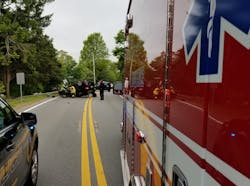The main goal of a department that provides its community with prehospital medical care and transport services should be to build and maintain a system that’s capable of delivering high levels of life-saving critical care service in a prompt, competent and professional manner.
To achieve this, departments require a significant amount of annual budget funding from the community that they serve. However, as most departments know, obtaining this financial support through conventional budget means can be an extremely difficult process.
To overcome these budgetary obstacles, many departments that provide EMS initiated billing programs that generate operating revenue by charging fees for patient care and transport services. Charging these fees allows departments to take advantage of a supplemental revenue source that has been built into the health insurance system for years. If used constructively, the income can lead to a reduced reliance on local taxes, improved service levels and fewer complications during the annual request for municipal budget funds.
For example, say the annual cost to run a fire-based emergency medical service is $2 million, and all of the financial support is generated through local taxes. Residents are on the hook for the entire amount. However, if $1 million of financial support is provided by your service fees, residents are on the hook for only $1 million, and the annual portion of the local taxes that’s destined to support EMS operations is reduced significantly. This undoubtedly is a win-win scenario.
Departments that offer these services and haven’t moved in this direction should explore this approach to offsetting operating costs. In my many years of experience managing fire-based EMS, I succeeded using such revenue to fund annual wage, benefit, capital, and operational costs to build and maintain quality patient care and effective transport organizations.
Strategic annexation
During the mid-to-late 2000s, the busy volunteer ambulance service in Englewood, NJ, the city where I formerly was employed, had difficulty maintaining personnel, filling shifts and responding to requests for service. In an attempt to resolve these issues and to improve service levels, the city initiated a program of furnishing the ambulance corps with annual funding to hire part-time EMTs. (Advanced life support [ALS] services in New Jersey are hospital-based by regulation.) This support proved beneficial in the short term. That said, the existing issues and new issues, such as inadequate daily supervision, poor accountability, low pay scales and repetitive requests for increased financing from the corps, continued to plague the system. Observing these service issues on a daily basis prompted the department to begin to lobby city officials to authorize the transfer of the ambulance corps’ part-time EMTs to the fire department. In 2008, city officials finally accepted the department’s assessment of the complex personnel, service and significant budget issues that the volunteer ambulance corps faced. As a result, the daily and weekend nighttime operations of the part-time EMTs officially were transferred to the fire department.
With a clean slate, the department moved quickly to implement a previously developed strategic annexation plan. It included assigning a fire department officer as the first-line supervisor of the part-time employees; writing and adopting standard operating guidelines; purchasing ambulances with fire department markings; assessing the staff for continued employment; hiring additional employees; and gaining licensure with the state of New Jersey. The most significant element of the plan included the initiation of an EMS billing program to relieve the ongoing strain that the ambulance corps’ substandard oversight of expenditures that were allocated to the part-time employee group had on the city’s financial resources. To fix this major issue, a local ordinance was adopted. It established an ambulance transport and patient care service fee program. The program was supervised by the newly created Englewood Fire Department Bureau of Emergency Medical Services. A third-party billing company was engaged.
As expected, the revenue that was generated during the first year of the program erased the part-time staff operational funding deficit that was customary under the guidance of the volunteer ambulance corps.
The initiation of the EMS billing program, the transfer of the operations of the paid EMTs and the resulting daily supervision that was provided by the department proved to be very successful. This success surfaced both financially and in the improvement of the level of EMS that was delivered to residents.
Unfortunately, after 2010, city officials eliminated the fire department EMS. They contracted with the local hospital, citing the need to reduce budgetary costs. In reality, politics—not cost—proved to be the primary motive for this decision.Overcoming Proposition 2½
After retiring in New Jersey, I was fortunate to be hired as the fire chief in the town of Brewster, MA. I assumed leadership of a department that provided EMS to the community at the ALS level and billed for the services for the previous 22 years.
A third-party billing system was in place for a considerable amount of time. As the new program manager, it was important to conduct an assessment of the system to identify its strengths, its weaknesses and any potential adjustments to ensure future financial stability. The results of the review exposed two key issues: an existing fee schedule that was less than that of surrounding communities and the state average; and a projected negative account balance. The latter resulted from an unspoken practice of using collected revenue for purposes other than supporting the operations of the fire/rescue department. To complicate matters, the state of Massachusetts (like some others) operates on a Proposition 2½ basis. This law places a limit on year-over-year increases in total property tax revenue (also known as the tax levy) that a town or city can impose, which significantly limits any increase in annual operating budgets. The importance of having an EMS billing system that generates revenue that’s dedicated to fire department EMS operations never could be greater than it is when it comes to the Proposition 2½ fiscal environment.
To fix the issues and to overcome the limitations of Proposition 2½, the town administrator, the finance team and my office implemented a long-term strategic correction plan that ensured accurate utilization of the generated revenue and secured the future economic stability of the revenue account.
Fortunately, these changes worked as expected, and, as of today, the department and the residents of the community continue to reap the benefits of the program. From an economic perspective, collected revenue is used to fund annual leases for three ambulances; a lease on a rescue/pumper, which is certified as a type V (non-transport) ambulance; regional dispatch costs; third-party billing fees; and training and education. The collected revenue also subsidizes a portion of the department’s annual budget.
One of the more critical operational needs that the program supports is the annual financing of the wage and benefit costs for two full-time firefighter/paramedics. They are essential to the department’s mission and the department’s capability to keep up with increased requests for service and the continual loss of call firefighters. Hiring and sustaining the employment of the full-time firefighter/paramedics prior to using revenue that’s collected from ambulance billing wouldn’t have been affordable nor feasible under the restrictions that are required by Proposition 2½ and that result from the community’s long tradition of rejecting new programs and/or new employees that are funded through any increase in the local tax rate.
Difficulty with officials
Although most of my experience managing the income from these programs leans toward the positive, I am sure that many departments had and continue to have extreme difficulties dealing with local officials in regard to the correct use of funds. This is unfortunate but not unexpected.
The last few pieces of advice for those who are looking to implement or who currently are responsible for overseeing a fire department EMS billing program are these: Make sure that an approved written policy that covers the use of the revenue is in place; develop a cooperative working relationship with those who manage the program (whether internally or through a third-party billing service); educate yourself as to the mechanisms of the system; and make it your mission to ensure that the collected income is directed appropriately and is used to support services that the department delivers to your community.
About the Author

Robert Moran
Robert Moran served as fire chief of the Brewster, MA, Fire Rescue Department from 2010–2024. Prior to that, he served 26 years with the Englewood, NJ, Fire Department, retiring in 2010 after 12 years as chief of department. Moran holds a master’s degree from Fairleigh Dickinson University, is a certified public manager, and has a Chief Fire Officer (CFO) designation from the Center for Public Safety Excellence. He serves as an adjunct instructor for Kean University and the New Jersey Division of Fire Safety and lectures at numerous regional and national fire service conferences. Along with his training partner, John Lewis, Moran writes the back page of the New York State Association of Fire Chiefs' Size-Up magazine and operates Jersey Guys Fire Service Training.

